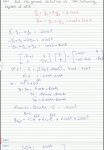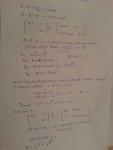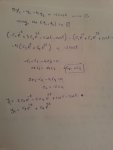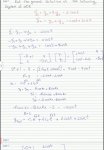You are using an out of date browser. It may not display this or other websites correctly.
You should upgrade or use an alternative browser.
You should upgrade or use an alternative browser.
help me with this general solution of the following system of ODE,
- Thread starter Max64
- Start date
D
Deleted member 4993
Guest
Please share your work with us ...
If you are stuck at the beginning tell us and we'll start with the definitions.
You need to read the rules of this forum. Please read the post titled "Read before Posting" at the following URL:
http://www.freemathhelp.com/forum/th...Before-Posting
Please share your work with us ...
If you are stuck at the beginning tell us and we'll start with the definitions.
You need to read the rules of this forum. Please read the post titled "Read before Posting" at the following URL:
http://www.freemathhelp.com/forum/th...Before-Posting

HallsofIvy
Elite Member
- Joined
- Jan 27, 2012
- Messages
- 7,763
I can see no logic in what you have done. Yes, the left side can be written as the matrix multiplication
\(\displaystyle \begin{bmatrix}-D+ 1 & 4 \\ 1 & -D+ 1\end{bmatrix}\begin{bmatrix}y_1 \\ y_2 \end{bmatrix}\) but that is NOT equal to your right side. Where did you get that second column? The right side must be a single column, not a 2 by 2 matrix. Is that next equation supposed to give the determinant? If so the product (-D+ 1)(-D+ 1) is NOT equal to "\(\displaystyle D^2+ 1\)!
Here is different but equivalent way of doing this problem: Differentiate both sides of \(\displaystyle y_1'= y_1+ 4y_2- 2 cos t\) again to get \(\displaystyle y_1''= y_1'+ 4y_2'+ 2sin t\). Use the second equation, \(\displaystyle y_2'= y_1+ y_2- cos t+ sin(t)\), to make the equation \(\displaystyle y_1''= y_1'+ 4(y_1+ y_2- cos t+ sin t)+ 2 sin t= y_1'+ 4y_1+ 4y_2- 4cos t+ 6 sin t\). Now solve the first equation for \(\displaystyle 4y_2\): \(\displaystyle 4y_2=y_1'- y_1+ 2 cos t\). Now substitute that into the previous equation. \(\displaystyle y_1''= y_1'+ 4y_1+ (y_1'- y_1+ 2 cos t)- 4 cos t+ 6 sin t= 2y_1'+ 3y_1- 2 cos t+ 6 sin t\).
So we reduced to the single equation \(\displaystyle y_1''- 2y_1'- 3y_1= 4 cos t+ 6 sin t\). That has characteristic equation \(\displaystyle r^2- 2r- 3= (r- 3)(r+1)= 0\) which has roots r= 3 and r= 1.
\(\displaystyle \begin{bmatrix}-D+ 1 & 4 \\ 1 & -D+ 1\end{bmatrix}\begin{bmatrix}y_1 \\ y_2 \end{bmatrix}\) but that is NOT equal to your right side. Where did you get that second column? The right side must be a single column, not a 2 by 2 matrix. Is that next equation supposed to give the determinant? If so the product (-D+ 1)(-D+ 1) is NOT equal to "\(\displaystyle D^2+ 1\)!
Here is different but equivalent way of doing this problem: Differentiate both sides of \(\displaystyle y_1'= y_1+ 4y_2- 2 cos t\) again to get \(\displaystyle y_1''= y_1'+ 4y_2'+ 2sin t\). Use the second equation, \(\displaystyle y_2'= y_1+ y_2- cos t+ sin(t)\), to make the equation \(\displaystyle y_1''= y_1'+ 4(y_1+ y_2- cos t+ sin t)+ 2 sin t= y_1'+ 4y_1+ 4y_2- 4cos t+ 6 sin t\). Now solve the first equation for \(\displaystyle 4y_2\): \(\displaystyle 4y_2=y_1'- y_1+ 2 cos t\). Now substitute that into the previous equation. \(\displaystyle y_1''= y_1'+ 4y_1+ (y_1'- y_1+ 2 cos t)- 4 cos t+ 6 sin t= 2y_1'+ 3y_1- 2 cos t+ 6 sin t\).
So we reduced to the single equation \(\displaystyle y_1''- 2y_1'- 3y_1= 4 cos t+ 6 sin t\). That has characteristic equation \(\displaystyle r^2- 2r- 3= (r- 3)(r+1)= 0\) which has roots r= 3 and r= 1.
Last edited:
thank u please if u dont mind check my final answer I have some douts


I can see no logic in what you have done. Yes, the left side can be written as the matrix multiplication
\(\displaystyle \begin{bmatrix}-D+ 1 & 4 \\ 1 & -D+ 1\end{bmatrix}\begin{bmatrix}y_1 \\ y_2 \end{bmatrix}\) but that is NOT equal to your right side. Where did you get that second column? The right side must be a single column, not a 2 by 2 matrix. Is that next equation supposed to give the determinant? If so the product (-D+ 1)(-D+ 1) is NOT equal to "\(\displaystyle D^2+ 1\)!
Here is different but equivalent way of doing this problem: Differentiate both sides of \(\displaystyle y_1'= y_1+ 4y_2- 2 cos t\) again to get \(\displaystyle y_1''= y_1'+ 4y_2'+ 2sin t\). Use the second equation, \(\displaystyle y_2'= y_1+ y_2- cos t+ sin(t)\), to make the equation \(\displaystyle y_1''= y_1'+ 4(y_1+ y_2- cos t+ sin t)+ 2 sin t= y_1'+ 4y_1+ 4y_2- 4cos t+ 6 sin t\). Now solve the first equation for \(\displaystyle 4y_2\): \(\displaystyle 4y_2=y_1'- y_1+ 2 cos t\). Now substitute that into the previous equation. \(\displaystyle y_1''= y_1'+ 4y_1+ (y_1'- y_1+ 2 cos t)- 4 cos t+ 6 sin t= 2y_1'+ 3y_1- 2 cos t+ 6 sin t\).
So we reduced to the single equation \(\displaystyle y_1''- 2y_1'- 3y_1= 4 cos t+ 6 sin t\). That has characteristic equation \(\displaystyle r^2- 2r- 3= (r- 3)(r+1)= 0\) which has roots r= 3 and r= 1.



